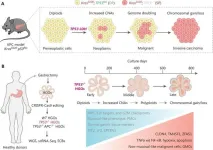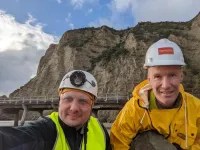(Press-News.org) Cheers erupted from a crowd gathered at the University of Colorado Anschutz Medical Campus on April 19 as leaders at the CU School of Medicine and the United States Air Force Academy (USAFA) signed an educational partnership agreement, a historic moment that will open a breadth of opportunities for both institutions.
“This is a very happy occasion for us and formalizes something that we always seek to have, which is a mutually beneficial partnership with colleagues in the state,” said John J. Reilly Jr., MD, dean of the CU School of Medicine, during the signing ceremony.
The partnership agreement will facilitate academic collaborations between CU Anschutz and USAFA, leveraging the expertise and capabilities of both institutions to further invest in developing exceptional leaders and improving the care of U.S. military service members. Under the agreement, the USAFA faculty and cadets, who are students at the academy, can participate in research and mentorship opportunities at CU Anschutz. CU School of Medicine faculty and students will be able to access facilities at the USAFA, such as the human performance laboratory and engineering facilities, to participate in research projects, mentorship opportunities, and internships for joint-funded efforts.
The partnership will also facilitate the creation of specialized joint training programs and seminars, advancing the missions of both institutions.
The partnership with the USAFA is the third educational partnership agreement the CU Center for Combat Medicine and Battlefield (COMBAT) Research has spearheaded. The other two agreements are with the Defense Health Agency and the Uniformed Services University.
“This is the first medical university that the USAFA has partnered with, and we’re proud of that,” said Col. Vik Bebarta, MD, founding director of the Center for COMBAT Research and professor of emergency medicine.
Bebarta, a USAFA graduate himself, explained how partnering with the academy will elevate the commitment to military medicine, reflecting the center’s mission to save and improve lives on the battlefield and at home.
Danielle Radovich Piper, senior vice president for external relations and strategy for the University of Colorado’s Office of the President, attended the ceremony on behalf of CU President Todd Saliman and shared enthusiasm for possibilities for collaborations between USAFA and other CU campuses.
“This is so exciting,” she said. “President Saliman extends his deep gratitude.”
Brig. Gen. Linell Letendre, dean of faculty for the Air Force Academy, describes the partnership as “absolutely imperative.” She noted USAFA’s mission to create exceptional leaders who know how to take risks and how to fail.
“Research helps you do both,” she said. “It helps you stand back up again, try it in a different way, look at the problem differently. We’re always looking for new ways for our cadets to dive into real world problems, so that’s one of the things we’re so excited about here, today.”
Col. Daniel Finkelstein, associate dean for research at the Air Force Academy, underscored the value of research to the academy.
“The Air Force has now directed the academy that research is not just a good thing to do, but actually is a part of its mission as a service academy,” he said.
A taste of what CU can offer
Since its inception, the Center for COMBAT Research has produced more than 70 solution-driven medical research projects funded by the U.S. Department of Defense. Through its research, the center helped change 19 military clinical practice guidelines, affecting 1.7 million service members, and modernized medical training for 39,000 combat medics and first responders, all providing strong research ties back to the USAFA faculty and cadets.
Beyond conducting research, the Center for COMBAT Research is also dedicated to developing innovative leaders through its education and mentorship initiatives, such as its scholar and fellowship programs. The mentorship opportunities the center plans to facilitate with USAFA will follow a similar model.
To demonstrate the variety of educational opportunities available through this partnership, COMBAT faculty and staff offered presentations and tours to Air Force Academy leaders on Friday.
One of the Center for COMBAT Research’s primary focus areas is psychological health and readiness. The Marcus Institute for Brain Health, which provides specialty care mostly for military veterans, first responders, and active-duty service members who are struggling with traumatic brain injuries and changes in psychological health, was one of the facility visits as part of the April 19 event. Retired Brig. Gen. Kathleen Flarity, DNP, PhD, deputy director of the Center for COMBAT Research and interim executive director of the Marcus Institute for Brain Health, led the tour.
“I’ve had some of the providers say that this is a sacred space and that it is such an honor to care for this population,” Flarity said.
Jay Lemery, MD, professor of emergency medicine and chief of the Section of Wilderness and Environmental Medicine, presented to USAFA leaders about revolutionary research being done on arctic medicine later in the tour.
Working in extreme temperatures can complicate life-saving interventions required for combat casualty care, he said.
From testing blood warming equipment to accessing frigid environments, the Center for COMBAT Research and the CU Department of Emergency Medicine are collaborating on several research initiatives to improve arctic medicine care.
“The goal is really to make this a multidisciplinary research platform,” Lemery said, highlighting the opportunity for collaboration with the USAFA.
Investing in future generations
Establishing the formal educational partnership agreement was exciting for leaders at CU Anschutz and the Air Force Academy, and was also a celebratory moment for Air Force Academy alumni and CU School of Medicine students and residents.
Among those celebrating was Austin Almand, a fourth-year medical student in the CU School of Medicine and a 2009 graduate from the USAFA. He said he was excited to hear about the educational partnership agreement because it means there will be more opportunities for cadets and medical students to work on collaborative research and education projects.
Also sharing in the excitement was 2nd Lt. Branson Taheri, MD, a Center for COMBAT Research fellow. Taheri graduated from the USAFA in 2019 and then attended Uniformed Services University. Now, he is completing an integrated vascular surgery residency at the CU School of Medicine.
“Up into this point in my career, I’d been at a military institution, receiving mentorship from military members all around me,” he said. “It’s been excellent to have the Center for COMBAT Research here that can really fill that role. There are so many great minds here at the University of Colorado, and to be able to combine those with unique military needs, I think, really is an excellent vehicle and recipe to have some pretty amazing results.
Anne Libby, PhD, professor and vice chair for academic affairs for the CU Department of Emergency Medicine, described the ways the Center for COMBAT Research specializes in the training of researchers, giving people the skills they need to build an externally funded research career. Libby oversees the educational partnership agreements for the Center for COMBAT Research.
“We want to help people facilitate the careers they envision for themselves,” Libby said. “We've got big problems to solve, and we cannot afford to lose the best minds.”
Brig. Gen. Letendre shared her connection to the Center for COMBAT Research’s mission to break down barriers in conducting research and setting students, residents, and faculty members up for success.
“That’s really the investment in those generations to come,” Letendre said.
END
CU Center for COMBAT Research and United States Air Force Academy form educational partnership
The new educational partnership agreement will support research, mentorship, and collaborative initiatives between CU and USAFA
2024-05-07
ELSE PRESS RELEASES FROM THIS DATE:
Road of no return — loss of TP53 paves a defined evolution path from gastric preneoplasia-to-cancer
2024-05-07
“The independent research groups, led by Prof. Scott W. Lowe and Christina Curtis,respectively, have uncovered a similar definitive pathway in the progression of gastric cancer (GC) initiated with loss of the TP53 gene, representing a milstone in understanding the early stages of this deadly disease”. Dr. Zhaocai Zhou, head of a GC laboratory from Fudan University, stated.“Their study offers detailed insights into how genetic changes drive the transformation from preneoplastic conditions to full-blown cancer. Their findings revealed that loss of TP53 is not merely a common genetic anomaly but a pivotal event that propels ...
Navigating the risks: safeguarding maternal and fetal health in emergency agitation treatment
2024-05-07
A recent review article provides critical insights into the management of acute agitation in reproductive-age females and during pregnancy within the emergency departments (EDs). The study emphasizes the importance of considering the safety of psychotropic medications in this demographic population, given the potential risks to both the patient and the fetus.
Agitation in the emergency department is not uncommon and can stem from various causes, including psychiatric disorders, substance abuse, and other medical ...
Telehealth program created to improve access to specialty care found to reduce reliance on opioids in pain management
2024-05-07
COLUMBIA, Mo. (May 7, 2024) ― More Americans suffer from chronic pain than diabetes, heart disease, and cancer combined. Yet, a shortage of pain medicine specialists persists, causing many pain sufferers to seek care in primary care settings.
Researchers from the University of Missouri School of Medicine have found that an innovative tele-mentoring program can help address reliance on opioids in the management of pain, with potential benefits for patients, families and communities.
Project Extension for Community Healthcare Outcomes (ECHO) is an innovative educational and mentoring model where ...
Advancing satellite-based PNT service: low earth orbit satellite constellations augment the GNSS
2024-05-07
A study has outlined the critical needs and essential technologies for a Low Earth Orbit (LEO) constellation to augment satellite navigation systems, significantly improving the Positioning, Navigation and Timing (PNT) services. This research specifically targets the diverse demands of different users for LEO augmented GNSS, the possible contribution of LEOs to PNT performances, and the key technologies referring to the LEO-based navigation augmentation system.
The Global Navigation Satellite Systems (GNSS), including the BeiDou Navigation Satellite System (BDS), are the most widely used in providing PNT services. However, GNSS signals from geostationary orbit (GEO), inclined ...
Researchers show that slow-moving earthquakes are controlled by rock permeability
2024-05-07
Earthquakes are the most dramatic and noteworthy results of tectonic plate movement. They are often destructive and deadly, or at the very least physically felt — they’re literally groundbreaking geological events. However not all tectonic movement results in effects that humans can perceive.
Slow slip events occur when pent up tectonic forces are released over the course of a few days or months, like an earthquake unfolding in slow motion. The more gradual movement means people won’t feel the earth shaking beneath their feet and buildings won’t collapse. But the lack of destruction does not make slow slip events less scientifically ...
Seeking medical insights in the physics of mucus
2024-05-07
WASHINGTON, May 7, 2024 – As much as we might not want to think about it, mucus is everywhere in our bodies. It coats our airways and our digestive systems and serves as a first line of defense against pathogens, a habitat for our microbiomes, and a conveyor belt for our insides to keep everything moving smoothly.
The front-line role of mucus means it is often the site of the first symptoms of infection or disease. Understanding how mucus changes, and what it changes in response to, can help diagnose illnesses and develop treatments. Designing a study to measure the physical properties of mucus, however, is nothing to sneeze at.
In APL Bioengineering, by AIP Publishing, ...
Study sheds light on cancer cell ‘tug-of-war’
2024-05-07
WASHINGTON, May 7, 2024 – Understanding how cancerous cells spread from a primary tumor is important for any number of reasons, including determining the aggressiveness of the disease itself. The movement of cells into the extracellular matrix (ECM) of neighboring tissue is an essential step in cancer progression that directly correlates to the onset of metastasis.
In APL Bioengineering, by AIP Publishing, a team of researchers from Germany and Spain used a breast cancer cell line panel and primary tumor explants from breast and cervical cancer patients to ...
Social determinants of health and the availability of cancer clinical trials in the US
2024-05-07
About The Study: Substantial geographic disparities in cancer clinical trials availability exist throughout the United States, with the most socially vulnerable counties being far less likely to have any trial and having only a fraction of trials available, a disparity that has worsened over time.
Corresponding Author: To contact the corresponding author, Rishi Robert Sekar, M.D., M.S., email rsekar@med.umich.edu.
To access the embargoed study: Visit our For The Media website at this link https://media.jamanetwork.com/
(doi:10.1001/jamanetworkopen.2024.10162)
Editor’s Note: Please ...
Multilevel characteristics of cumulative symptom burden in young survivors of childhood cancer
2024-05-07
About The Study: The findings of this study suggest that symptoms are prevalent years after young childhood cancer survivors’ initial cancer diagnosis, and interventions to reduce caregiver anxiety and neighborhood adversity and improve resilience may alleviate symptom burden.
Corresponding Author: To contact the corresponding author, I-Chan Huang, Ph.D., email i-chan.huang@stjude.org.
To access the embargoed study: Visit our For The Media website at this link https://media.jamanetwork.com/
(doi:10.1001/jamanetworkopen.2024.10145)
Editor’s Note: Please see the article for additional information, ...
Why getting in touch with our ‘gerbil brain’ could help machines listen better
2024-05-07
Macquarie University researchers have debunked a 75-year-old theory about how humans determine where sounds are coming from, and it could unlock the secret to creating a next generation of more adaptable and efficient hearing devices ranging from hearing aids to smartphones.
In the 1940s, an engineering model was developed to explain how humans can locate a sound source based on differences of just a few tens of millionths of a second in when the sound reaches each ear.
This model worked on the theory that we must ...
LAST 30 PRESS RELEASES:
Post-stroke injection protects the brain in preclinical study
Cardiovascular risk score predicts multiple eye diseases
Health: estimated one in ten British adults used or interested in GLP-1 medications for weight loss
Exercise to treat depression yields similar results to therapy
Whooping cough vaccination for pregnant women strengthens babies’ immune system
Dramatic decline in new cases of orphanhood in Uganda driven by HIV treatment and prevention programs
Stopping weight loss drugs linked to weight regain and reversal of heart health markers
Higher intake of food preservatives linked to increased cancer risk
Mass General Brigham–developed cholera vaccine completes phase 1 trial
First experimental validation of a “150-year-old chemical common sense” direct visualization of the molecular structural changes in the ultrafast anthracene [4+4] photocycloaddition reaction
Lack of support for people on weight loss drugs leaves them vulnerable to nutritional deficiencies, say experts
Dogs’ dinners can have greater climate impact than owners’
Are you ready to swap salmon for sprats and sardines?
1.6 million UK adults used weight loss drugs in past year
American College of Cardiology comments on new dietary guidelines for Americans
American Society of Gene & Cell Therapy and Orphan Therapeutics Accelerator partner to advance and commercialize promising rare disease treatments
One in 14 patients having day case surgery have new or worse chronic pain 3 months after their operation
New study highlights link between eviction rates and gun violence
Heatwaves heat up soil but not toxin levels in rice, study finds
Digital modeling reveals where construction carbon emissions really come from
Turning farm waste into water filters
New study shows how the spleen helps the immune system accept a transplant
New Mayo Clinic study advances personalized prostate cancer education with an EHR-integrated AI agent
Researchers identify novel therapeutic target to improve recovery after nerve injury
Microbes in breast milk help populate infant gut microbiomes
Reprogramming immunity to rewrite the story of Type 1 diabetes
New tool narrows the search for ideal material structures
Artificial saliva containing sugarcane protein helps protect the teeth of patients with head and neck cancer
Understanding the role of linear ubiquitination in T-tubule biogenesis
Researchers identify urban atmosphere as primary reservoir of microplastics
[Press-News.org] CU Center for COMBAT Research and United States Air Force Academy form educational partnershipThe new educational partnership agreement will support research, mentorship, and collaborative initiatives between CU and USAFA





